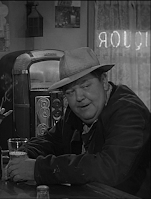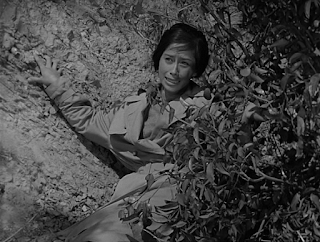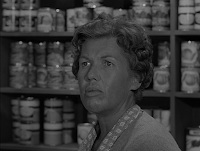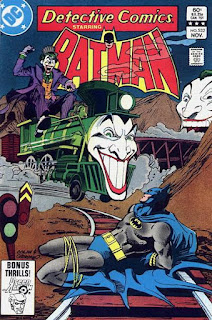"Lurid Love" is an on-the-nose clever send-up of the "Confessions" rags of the time, complete with faux-but-believable ads. Sammy's golden moment (reprinted to the right) was my spit-the-whiskey-out-laughing panel of the issue. I found the remainder of the issue to be gorgeously illustrated but familiar in the plot department. Still, this was the strongest issue of The Spirit in some time.
 |
| Torres |
Vampirella #53
"The Human Marketplace" ★★★
Story by Gerry Boudreau
Art by Jose Gonzalez
"Opium is the Religion of the People" ★1/2
Story by Gerry Boudreau
Art by Rafael Auraleon
"The Professional" ★★
Story by Bruce Jones
Art by Zesar
"The Last Man Syndrome" ★1/2
Story by Roger McKenzie
Art by Ramon Torrents
"Jackie and the Leprechaun King" ★
Story by Bill DuBay
Art by Esteban Maroto
Crossing the US/Mexico border, Vampirella and Pen are stopped after Vampi's phony passport is flagged. A CIA agent named Spectrum (of course!) approaches Vampi and asks for her cooperation in a case involving a white slavery ring. With no obvious options, our Drakulonian Diva agrees and heads for San Francisco, where she hangs out in a seedy bar filled with salty seamen (ooooh, I just couldn't wait for the obvious typos on that one!).
Sure enough, within minutes, V is harassed by a sailor (wearing stripes, as if the vampiress were whisked back into Barbary Coast days) and eventually drugged and kidnapped. When she awakens, Cap'n Silver explains to her that she'll be brainwashed, sold to a wealthy foreigner with power, and then instructed to murder her "master." Silver explains that the same scenario will take place simultaneously around the world. Vampirella is dumped into a cell with several other captives.
When V runs out of her blood formula, she takes a bite out of one of her fellow inmates, only to discover that the girl has no blood! She's been transformed into a "cybernaut"! Taking wing, our heroine targets one of the sailors who kidnapped her. The man explains that Cap'n Silver's process not only brainwashes the victims but turns their bodies into "synthetic plastic." Holy Cow! The tar further elaborates that the girls are meant to make love to their "masters" and at just the right moment their bodies will explode! Holy Cow!
Vampi dines on the sailor and his dying screams alert Cap'n Silver, who enters the room armed with a gun. He takes a shot, but Vampi does a bat-change and avoids the bullet. Silver runs out the door and falls into a quicksand marsh, sinking out of sight. Meanwhile, the other sailors have decided that they're going to give the girls a test drive, unaware of the consequences. The bang ends with a literal bang. Vampi is congratulated by agent Spectrum and given a proper fake passport and birth certificate. The future is wide open.
It's almost inane to raise my hand in class and ask about silly plot points (if Vampi is so afraid of the border agents, why doesn't she turn into a bat and meet Pen on the "other side"?), but "The Human Marketplace" is so crammed full of head-scratchers and cliches, I almost feel I'd be amiss ignoring them. Where is this island just outside of "San Francisco harbor?" Neither Alcatraz nor Treasure Island have the lush jungle foliage present and the nearest island would be Hawaii, wouldn't it? A few days' journey, at least.
Why would the CIA figure V is the perfect woman to go undercover on this assignment? What in their folder shows them she could be an asset? That she's a heck of a prop in a vaudeville act? What does Pen do while he's lounging around San Fran waiting for his girl to do all the work? Never mind, I think we can guess that one. Why is Vampirella always short on her faux-blood supply? It reminds me of the old
Ultraman show where the big silver guy's chest-light would always start blinking in the middle of a big fight, signaling his power was running low.
But, hell, forget all that. "The Human Marketplace" is the most entertaining Vampirella chapter we've seen in years, dumb as a Motley Crue boxed set and equally void of vitamins. Boudreau discards all the eye-rolling seriousness we've seen in recent installments and goes for sheer nuttiness. If all Vampi stories were like this one, I'd be a lot less cranky.
 |
| (Insert eye-rolling emoji here) |
A man searches the Naked City for the Snowman, a drug dealer who kept his sister addicted to heroin. He finally finds the scum in an abandoned amusement park and closes in for the kill. Turns out the Snowman has a gang of monster bodyguards that our hero must contend with before he rains hell down and achieves some sort of peace with his vengeance.
Having plumbed the depths of bad Harlan Ellison imitation, Gerry Boudreau turns his sights on the dark and violent world of McBain and Westlake and has just as much success with "Opium is the Woman of the World," er sorry, "Woman Loves Opium in Her World".... whatever. Simply attempting to imitate the style of hardboiled does not make a story hardboiled, as we see from the brain-dead metaphors dotting the landscape. The Manhattan skyline appeared on the horizon a supine glamour queen lying nude on a bed of darkness, her face wet with autumn rain sure sounds like the opening of an 87th Precinct novel but, believe me, Hunter/McBain never wrote a line so pretentious and solipsistic. The unchecked wave of racism bits here and there continues even into the Louise Jones era, with Gerry's character commenting on the "yellow munchkins in rice fields" he fought during the war. I'm amazed this crap has been pretty much ignored over the years.
 |
Check out the "carefully prunned (sic) rows of shrubbery,
arrowing down the alibaster (sic) length of sidewalk..."
|
Peter Grant uses his good looks to first bed and then extort money from the beautiful housewives of Santa Mira. But when the women get wise to Grant's game, they join forces and end his little game. But one of them has actually learned a good lesson from the exercise. The final twist is a good one, but I have to say "The Professional" was way too long and boring. Halfway through the story, anyone with half a brain would know where this was going. I refuse to be a fanboy and add an extra star just because "The Professional" was written by my favorite horror comics writer. I have my scruples after all <wink emoji>.
A man walks the empty streets of the city, imagining the world has come to an end, even though a woman is being burned at the stake before his very eyes. In the end, he has what the Warren Publishing Company's psychiatrists term "The Last Man Syndrome." As he falls to the ground, people walk over him and trample him. The End.
When I finished "The Last Man Syndrome," I wondered when Jim Warren sent out the memo to his staff that the stories printed in Warren zines should change the world, not scare the reader. I wish I could remember my reaction as a 14-year-old Warren zombie to the McGregor, Moench, Boudreau, and McKenzie tales of inner turmoil and the human condition. The 45-years older me feels the strain of eye-rolling constantly through flowery sentences derived from entirely too much summer school required reading: Well, he had his privacy now. He didn't even feel the passing of a million feet that relentlessly trampled his lifeless body. He couldn't hear the numbling (sic) angry voices cursing him because he had gotten in their way. I can understand now why Jim W. never hired a proofreader. The guy woulda been at the office 24/7.
Little Jackie Paper loves his books filled with fantasy, but he's not very fond of his alcoholic father. So, one day, Jackie decides to head out on his own to find glory over the nearby hills. What he finds in the forest is the cute, lovable, and oh so adorable leprechaun, Bubba (
not Baba... that would be plagiarism!) O'Reilly and his pet dragon, Fluff (
stop... my sides are aching!). Together, the trio fights battles and enjoys incredible adventures until they run into Blackbeard and his cutthroat pirates. Bubba and Fluff are both slain, but Jackie is spared. That's because Blackbeard is, in reality, Jackie's dad, who explains that the "demon monsters" had cast a spell on the lad to convince him that they were the good guys. There was no Bubba and Fluff. Now, Pop explains, it's time for Jackie to grow up! As Jackie Paper walks away from the (imagined) bleeding carcass of Fluff, he sighs and thinks how much fun the evil villains were.
If this is the new "Golden Age of Warren," I think I'll go back and re-read Creepy #49 and Eerie #39, thank you very much. While I wasn't nearly as angered by "Jackie and the Leprechaun King" as Peter, Paul, and Mary should have been, it's still not my desired field of leisure reading material. What's Dube's message, exactly? That adulthood is for the birds? Now there's a viewpoint seldom shared. Can't wait for Dube's take on "Yellow Submarine." Maroto's art is the pits, little more than early sketches stolen off napkins.
This month, Joe Brancatelli discusses the sudden firing of Carmine Infantino at DC and Marvel's musical-editorial-chair. Joe also brings up the fact that comic sales are down at least 30% from the previous year (a trend that will continue every year) and gets in a couple of snarky (but well-deserved) jabs at Stan Lee and Warren Publishing itself. I miss Joe Brancatelli.-Peter
Jack-Peter, that's the same Joe Brancatelli column we read two weeks ago in
Creepy #81. Still, it's better than the comics on offer this time out. Unlike you, my favorite story was "Opium is the Religion of the People," mainly because Auraleon was the perfect choice to illustrate this grim tale. Boudreau is clearly a fan of classic films and even slips in a cameo by Dr. Archaeus among the rogues' gallery on the wall. I was happy to see Gonzalez back drawing Vampi, but his art doesn't seem as good as it used to and the story is a mixed-up mashup of cybernauts, a vampire, white slavery, and
The Most Dangerous Game.
I was also glad to see a story by Bruce Jones, but "The Professional" is ruined by the terrible art, unnecessarily violent end, and silly twist. Still, it's better than "The Last Man Syndrome"--when a writer spends an entire story making the reader wonder what the heck is going on, the payoff had better be good, and this one isn't. Finally, "Jackie and the Leprechaun King" is more DuBay page filler with decent Maroto art. I really think the editor just gave DuBay a page count and he wrote till he filled it.
 |
| Maroto |
Creepy #82
"Forgive Us Our Debts"
"A Most Private Terror"
"Deja Vu"
"Relatives!"
"A Scream in the Forest"
An all-Maroto reprint "Super Special Summer Giant" (though I'd question 76 pages being a "giant") proves that too much Maroto isn't necessarily a great thing. The scripts are, for the most part, decent, but Maroto's style should be absorbed in medium doses. That way you don't realize that Esteban's males all look like golden gods.-Peter
Jack-The best page of this issue is the new Brancatelli column, where he writes that many comic scribes look down on their readers and argues that comics were of higher quality in the 1960s and consequently sold better. I'm not sure I buy the second part of his argument.
Looking back over my comments on these five reprints that feature Maroto art, I see a theme--the guy can draw but he's not a good storyteller. The best of the lot is "A Scream in the Forest," and Warren colored a couple of its panels to cobble together a nice cover. "Deja Vu" is presented in color, though it was originally black and white. Four of the stories were first published in Creepy with cover dates in the first half of 1973, while the fifth is from a 1974 issue of Vampirella. At least (for once) Warren is not reprinting recent stories.
 |
| Sanjulian |
Eerie #76
"Deliver the Child"★★
Story by Budd Lewis
Art by Leopold Sanchez
"Highsong"★★★
Story by Budd Lewis
Art by Luis Bermejo
"Oogie and the Scroungers"★1/2
Story by Bill DuBay
Art by Esteban Maroto
"The Silver Key"★
Story and Art by Jose Bea
"Beware Darklon the Mystic!"★★★
Story and Art by Jim Starlin
In 1936, cousins Gerome and Jason have a club they call the Moonweavers, dedicated to exploring the unknown. Jason has supernatural powers and senses something strange going on; the boys follow the brain waves to a spooky old house on Blake Street and find Mr. Diggers (from the hardware store) in the basement, summoning up a demon. The demon is not happy that Mr. Diggers commands it to keep watch over his baby daughter for the rest of her life and, when the boys distract Mr. Diggers, the magic barrier is broken momentarily and the demon springs to attack the man who summoned it. Mr. Diggers snaps back to attention and re-establishes the barrier just in time to sever the demon's hands, the only part of its body that had passed through the barrier. The demon is furious and somehow rushes upstairs, where it chews off the hands of Mr. Diggers's beloved daughter.
Peter and I don't always do these posts in order, and I can see from his comments below that he gauged my reaction to "Deliver the Child" accurately. It starts out as another boring bit of nostalgia, gets interesting when the boys encounter Mr. Diggers in the basement (I think he's nude, but fortunately Sanchez is good at shadow placement), and becomes horrible at the needlessly violent end. Stories like this one are part of the reason I never read Warren comics as a kid. This ending is shock for shock's sake. How does the demon bypass the barrier at the end when he's mad? It reminds me of the dogs next door who run right through the electric fence when they see a deer.

In 1799, a crusty old loner named "Wolfer O'Connel" lives alone out West, chopping wood and avoiding bathing. One day, some Indians approach him without warning and he doesn't take kindly to it, so he plays a trick on them before slaughtering them with his axe. The Indians were afraid of an evil spirit that Wolfer soon discovers is a great big mix of wolf and bear; Wolfer fights it off before luring a pack of wolves to kill it (and themselves) in a fall off a cliff.
Luis Bermejo's art in "Highsong" is reminiscent of Berni Wrightson's, especially in the long shots; his closeups of Wolfer's face aren't quite as good. The story suffers from more over-writing by Lewis, as well as more graphic violence, when Wolfer slaughters the Indians. Still, it is set in the wilderness, so it doesn't seem quite as out of place as that of the prior story.
Buck Blaster, Prunella McShatters, and Oogie (the god) are visited by an IRS ship looking to collect back taxes. Prunella uses her godlike powers to blow up the ship and she and Buck return to life on their lonely planet.
"Oogie and the Scroungers" (the scroungers are the IRS agents) is another overly long, unfunny adventure featuring people none of the readers could care less about. Maroto does know his way around the female form, so Prunella is a visual delight, but DuBay once again fills pages with meaningless drivel. His attempt at humor completely falls flat.
On his way to school one day, young Peter Hypnos encounters a painter in the village square. Peter is hurled into a painting, where a strange creature hands him "The Silver Key." Peter unlocks the door to his future and meets more bizarre creatures; eventually, he finds his way home, but his mother doesn't believe his tall tales.
As Peter points out, Jose Bea's artwork here is a direct swipe of the work of Terry Gilliam on the Monty Python TV show, which had taken America by storm when it began airing on PBS in late 1974. For me, the Gilliam skits have dated badly, and so have these Bea stories starring Peter Hypnos.
Two dangerous men meet across a table in a cabaret and stare each other down. One of them, a professional assassin named Koph-Fan, explains that he was hired to kill a crown prince named Darklon. Koph-Fan and three other dangerous men tracked Darklon to a bedchamber, where they mistakenly killed his girlfriend. Darklon took revenge by murdering the other three. Suddenly, Koph-Fan attempts to kill the man across the table, who is Darklon, but fails. In return, Darklon kills Koph-Fan after torturing him to learn the name of the man who hired him: Kavar Darkhold, Darklon's beloved father.

Never having read the series that begins with "Beware Darklon the Mystic," I'm intrigued, mainly because it's mid-'70s work by Jim Starlin. As a kid, of course, I loved Captain Marvel and Warlock and, while the art here is not up to the level of his Marvel work, the story is enjoyable and has some of the usual Starlin touches. I look forward to seeing where this goes. It's interesting to see an ending that seems like a Star Wars rip-off, yet it came before Star Wars.-Jack
Peter-Perhaps because it mines the fields laid down by Mr. Bradbury, I liked "Deliver the Child" a lot. I'm sure Jack will not like its uber-vicious climax, but I prefer my horror stories dark and grim. I'd also prefer them to be void of typographical errors (and this story is an example of what happens when you don't proof a zine before it heads to the printer), but, hey, I'll take a good story over good punctuation anytime. Yes, the back of my brain wonders if I enjoyed this story so much because the rest of the crop is moldy and derivative. I will say that the setup is very confusing.
I also really enjoyed the sole adventure of Wolfer O'Connell, a series that surely would have been more tolerable than
Hunter or
Freaks in the long run. Bermejo's art is some of his best; I liked that Budd didn't take time out to explain what the wolf-bear-thing was. It just was.
No amount of force-feeding will ever get me to see the bright side of crap like "Oogie" and "Peter Hypnos." Both have their fans, I'm sure, but neither swings my pendulum. Dube's cutie-pie nicknames and dopey dialogue ("Prunie's terrific at washing dishes... and I can always pump munchkin gas...!") leave me nauseous and I'll be a happy man when I don't have to look at Jose Bea's Monty Python homages again. Does Jose ever get back to being that artist that could creep you out with just a panel of two men talking in a diner?
The complicated saga of Darklon has been dissected many times before (this is a great place to find out more), so I won't waste space other than to say that Starlin was a master, but this wasn't his masterpiece. In my long-ago assessment of the Eerie serials, I said: Of all the Eerie series, this one–-Jim Starlin’s homage to Steve Ditko’s Dr. Strange (at least, I think it’s an homage)-–is the most out of place. “Darklon” cries out for Marvel Premiere of the mid-1970s. Having re-read the opener just now, I haven't changed my mind.
 |
Next Week...
Another old fave returns! |




















































